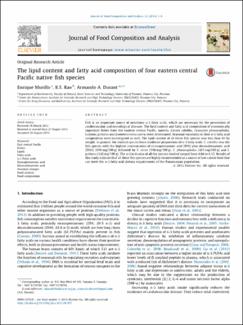| dc.contributor.author | Murillo, Enrique | |
| dc.contributor.author | Rao, KS Jagannatha | |
| dc.contributor.author | Durant-Archibold, Armando A. | |
| dc.date.accessioned | 2020-06-28T01:25:02Z | |
| dc.date.available | 2020-06-28T01:25:02Z | |
| dc.date.issued | 2014-02-01 | |
| dc.identifier.other | http://dx.doi.org/10.1016/j.jfca.2013.08.007 | |
| dc.identifier.uri | http://repositorio-indicasat.org.pa/handle/123456789/133 | |
| dc.description | Fish is an important source of nutritious n-3 fatty acids, which are necessary for the prevention of cardiovascular and neurological diseases. The lipid content and fatty acid composition of economically important fishes from the eastern central Pacific, namely, Caranx caballus, Cynoscion phoxocephalus, Lutjanus guttatus and Scomberomorus sierra, were determined. Seasonal variations in their n-3 fatty acid composition were investigated as well. The lipid content of all these fish species was less than 4% by weight. In general, the studied species have moderate proportions of n-3 fatty acids. C. caballus was the fish species with the highest concentration of eicosapentaenoic acid (EPA) plus docosahexaenoic acid (DHA) (898 mg/100 g) followed by S. sierra (596 mg/100 g), C. phoxocephalus (421 mg/100 g) and L. guttatus (342 mg/100 g). The n-3/n-6 ratio of all the species studied ranged from 4.86 to 8.12. Results of this study indicate that all these fish species are highly recommended as a source of low calorie food that can meet the n-3 fatty acid dietary requirements of the Panamanian population. | en_US |
| dc.description.abstract | Fish is an important source of nutritious n-3 fatty acids, which are necessary for the prevention of cardiovascular and neurological diseases. The lipid content and fatty acid composition of economically important fishes from the eastern central Pacific, namely, Caranx caballus, Cynoscion phoxocephalus, Lutjanus guttatus and Scomberomorus sierra, were determined. Seasonal variations in their n-3 fatty acid composition were investigated as well. The lipid content of all these fish species was less than 4% by weight. In general, the studied species have moderate proportions of n-3 fatty acids. C. caballus was the fish species with the highest concentration of eicosapentaenoic acid (EPA) plus docosahexaenoic acid (DHA) (898 mg/100 g) followed by S. sierra (596 mg/100 g), C. phoxocephalus (421 mg/100 g) and L. guttatus (342 mg/100 g). The n-3/n-6 ratio of all the species studied ranged from 4.86 to 8.12. Results of this study indicate that all these fish species are highly recommended as a source of low calorie food that can meet the n-3 fatty acid dietary requirements of the Panamanian population. | en_US |
| dc.language.iso | en | en_US |
| dc.subject | L. guttatus | en_US |
| dc.subject | C. phoxocephalus | en_US |
| dc.subject | C. caballus | en_US |
| dc.title | The lipid content and fatty acid composition of four eastern central Pacific native fish species | en_US |
| dc.type | Article | en_US |

